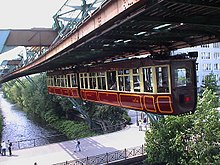Kaiserwagen: Difference between revisions
Appearance
Content deleted Content added
Magioladitis (talk | contribs) m clean up / fix section header naming (MOS:SECTIONS), added orphan tag using AWB |
Added "Not English inline" template to two phrases that appear to be untranslated from German. |
||
| Line 1: | Line 1: | ||
{{Orphan|date=December 2016}} |
{{Orphan|date=December 2016}} |
||
[[File:Wuppertal kaiserwagen.jpg|thumb|right|Historischer Kaiserwagen]] |
[[File:Wuppertal kaiserwagen.jpg|thumb|right|Historischer Kaiserwagen{{Not English inline}}]] |
||
[[File:Wuppertal Samuel fährt Schwebebahn 326.JPG|thumb|right|Führerstand]] |
[[File:Wuppertal Samuel fährt Schwebebahn 326.JPG|thumb|right|Führerstand{{Not English inline}}]] |
||
'''Kaiserwagen''' is a famous car on the [[Wuppertal Suspension Railway]] that was built in 1900. Kaiserwagen is rentable for tourists, weddings, meetings and ceremonies. The route is parallel to the daily line traffic, but the train doesn't stop at the regular stations. |
'''Kaiserwagen''' is a famous car on the [[Wuppertal Suspension Railway]] that was built in 1900. Kaiserwagen is rentable for tourists, weddings, meetings and ceremonies. The route is parallel to the daily line traffic, but the train doesn't stop at the regular stations. |
||
Revision as of 01:20, 16 May 2018


Kaiserwagen is a famous car on the Wuppertal Suspension Railway that was built in 1900. Kaiserwagen is rentable for tourists, weddings, meetings and ceremonies. The route is parallel to the daily line traffic, but the train doesn't stop at the regular stations.
Kaiserwagen was named after the visit and ride of Kaiser Wilhelm II with his consort Augusta Victoria of Schleswig-Holstein on October 24, 1900. The visit was a planned test drive with a "novel and revolutionary means of transport."
Today Kaiserwagen, including the Wuppertal Suspension Railway, is under monument conservation since May 26, 1997.
External links
Wikimedia Commons has media related to Kaiserwagen.
